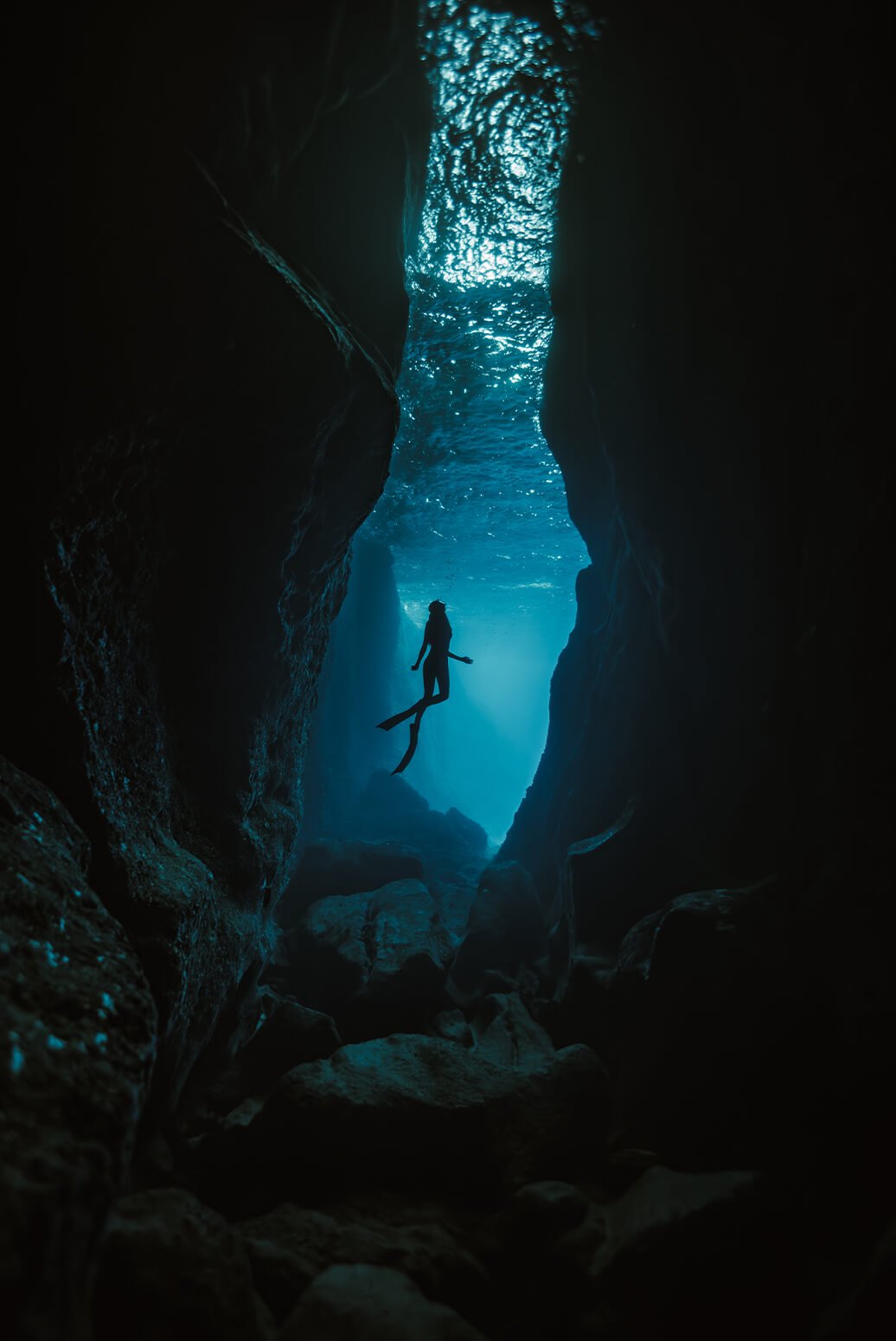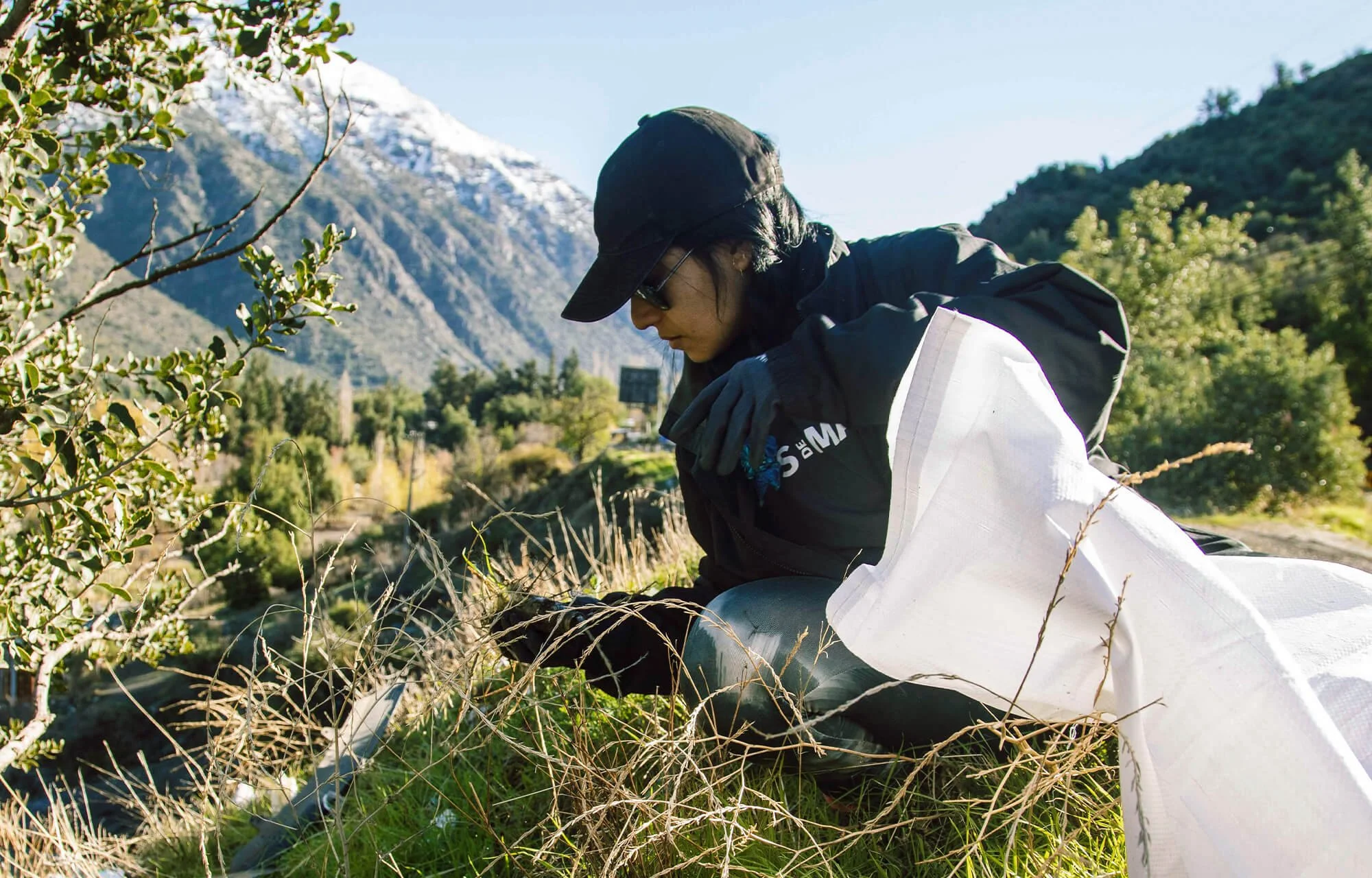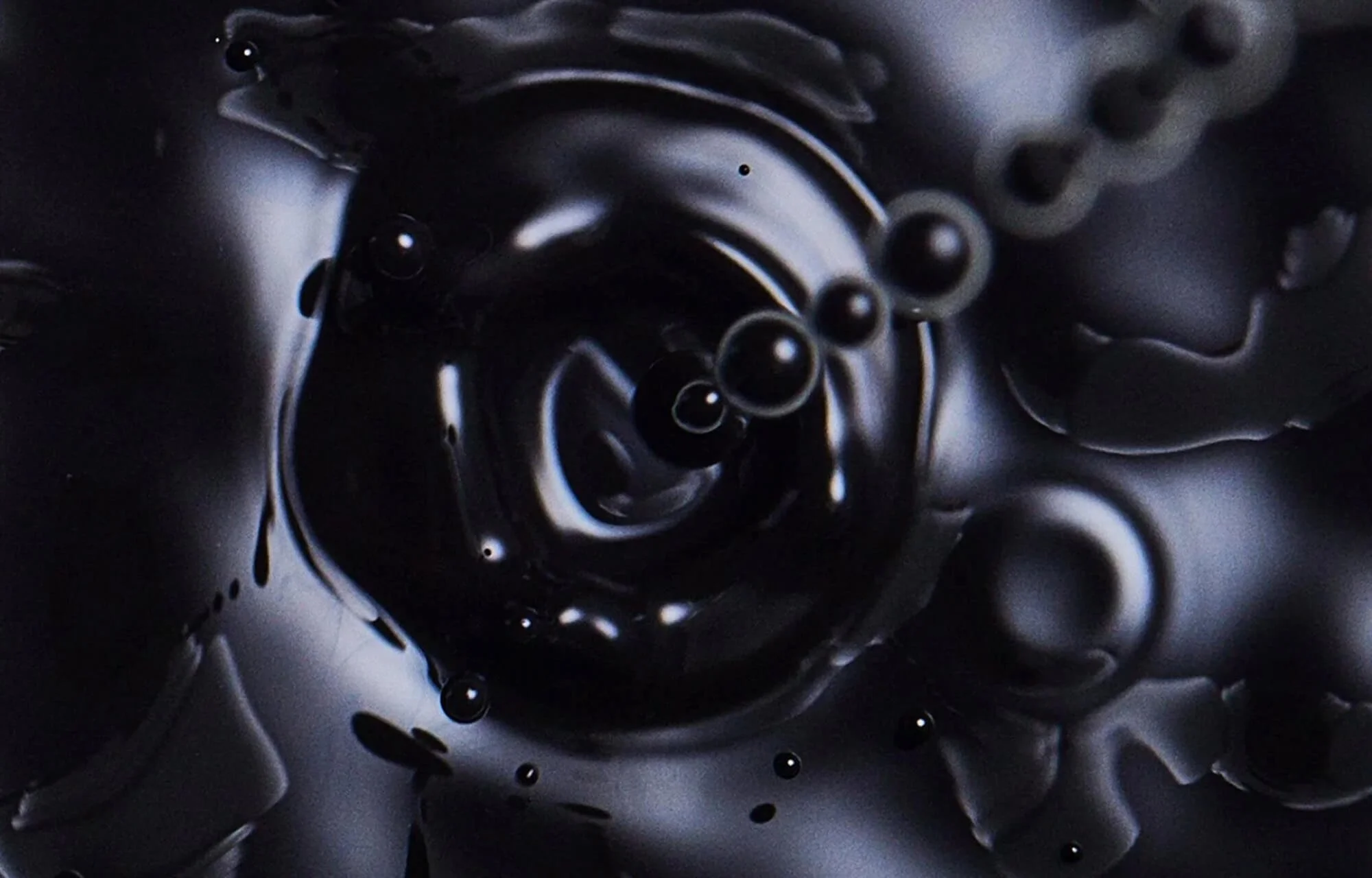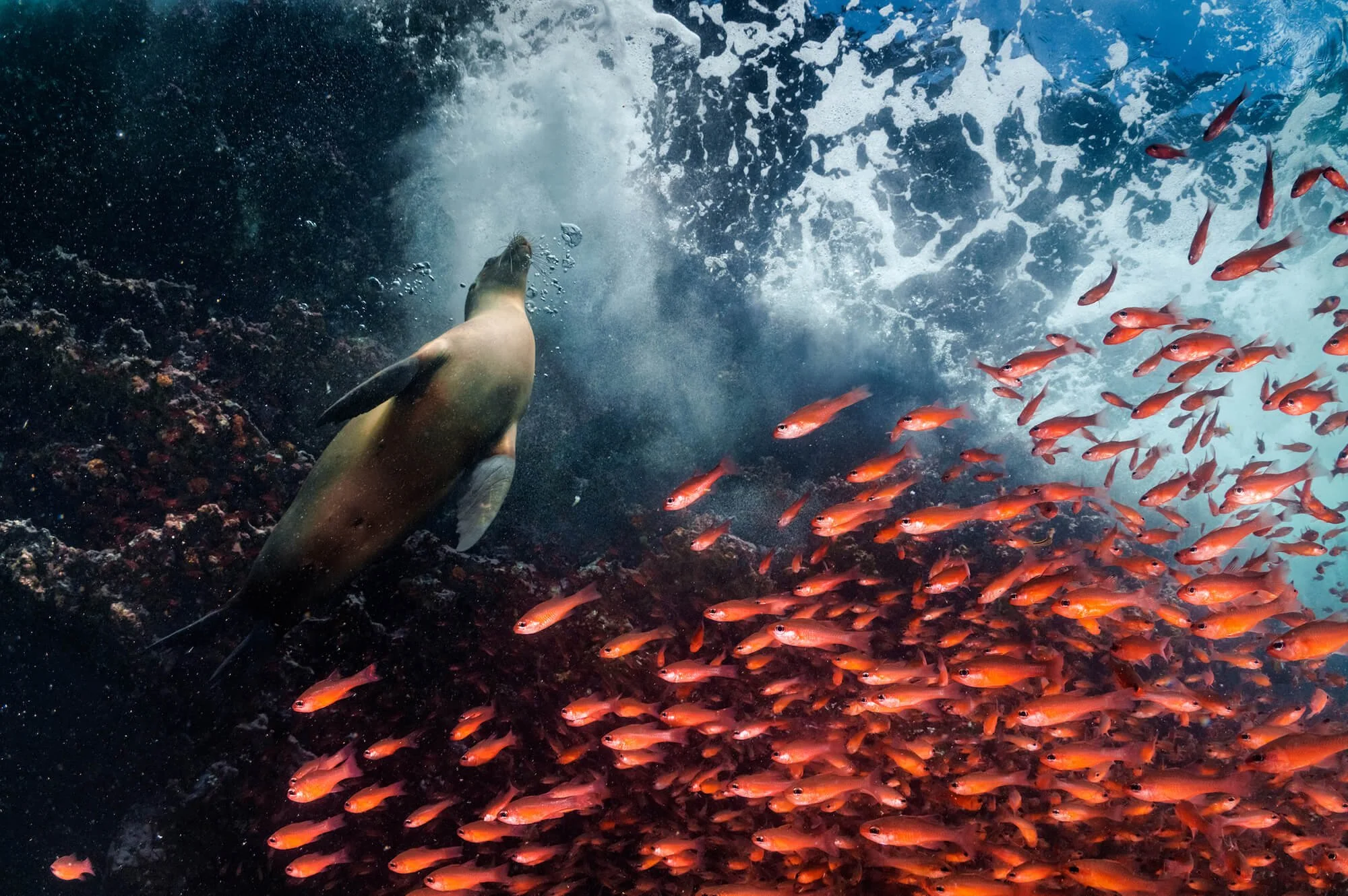In Focus: Camila Torres
Trading fashion for fish — how a trip to Thailand helped a photographer feel reborn in the water
There’s a nagging societal pressure to have life somewhat sorted by your 30th birthday. The expectation is that your 20s are the defining decade. If navigated with purpose and intention, you can lay down roots for professional and personal growth. This illusion of a linear, predictable life path, however, is dissolving as the world turns and a more connected creative population shares their stories online. It is never too late — or too early, for that matter — to change everything and build a career around your dreams. The end of one chapter is always a new beginning, at least in hindsight. Even the ocean supports this. Our planet’s largest ecosystem holds endless possibilities for discovery and renewal for those who leave familiar shores. No wonder the most likely birthplace of life on Earth is where so many of us go to feel reborn.
Growing up in Argentina, Camila Torres, who goes by Cami, enjoyed the water of her home river, but never imagined that it was possible to build a life below the surface. How does one become a professional ocean photographer? It’s a question many of us have pondered, scrolling the dreamy, curated feeds of content creators who hone their craft on held breath and oxygen tanks. It looks endlessly adventurous and exciting, but how many actually find the courage to dive in and learn what it takes?
Cami, who is now 39, quickly explains that she was in her early 30s when she made the decision that changed her life. After a vacation in Thailand, she decided to book another flight back. From there she enrolled in scuba courses, earned her open water certification, acquired a camera, and turned her newfound passion into the heartbeat of her career. Formerly focused on fashion and commercial photography, Cami describes a seismic shift and clarity that came with time in the water: “It’s where all the pieces come together.” Today, she can’t imagine her life without the ocean.
We caught up with Cami from her home in Thailand, after she spent time in Mexico documenting the Mesoamerican Reef and supporting the launch of a Parley partnership that aims to reconnect individuals and communities to their love of the oceans. She talked through her journey into underwater photography and offers some encouraging perspective on what she’s learned from the ocean along the way. Everything is temporary: the light, the status quo, whatever routine you feel you’re stuck in now, nothing is forever unless you choose to stay put. Anything can happen. As Cami explains, you never know what awaits in the water. That’s the magic of the unknown.
“Every moment I’m in the water, I’m learning something.”
Camila Torres
Q & A
How did you get into ocean photography?
Camila Torres: The journey for me started when I was 31. I just made a trip to Thailand for vacation and tried scuba diving. I was already a photographer, but more focused on fashion and products. When I tried diving, it blew my mind. I was like, okay, I just want to figure out how I can take pictures of the ocean, the corals, everything. Life was suddenly blowing my mind, everything about it.
After I returned to Argentina, I decided to move to Thailand to start scuba diving. And yes, I left everything behind. I just moved to Koh Tao, Thailand, and I started to take all the courses in open water… I kept advancing, and at some point I started to take pictures underwater. The school where I was working bought me a camera, a little one, and I started to take pictures. It was amazing. I started to make videos and share them on Instagram. That helped me start to grow a little more. I start to grow a little more, sharing it in my stories. At the time, six or seven years ago, it was still somewhat new in the scuba diving world. Not many people were doing it then. Now it's super common and everyone is filming…
Growing up in Argentina, what role did the ocean play in your childhood? Did you feel like diving later in life helped you reconnect to something from before?
I was born in a small city called Concepción del Uruguay, Entre Ríos, in Argentina. We have a river there, Río Uruguay, and through that I was always connected with water. For example, we would water ski and everything, but never did too much directly with the ocean. That came more when my family would travel. I never imagined myself underwater.
On your website, you describe yourself as ‘‘pushing button since 2004’. What was the moment that made you decide to give underwater photography a chance?
I had been working with companies for years, mostly selling clothes— then everything changed at that dive school, after one vacation here in Thailand. I tried scuba diving, was there for one month and just went back to Argentina. But I was super obsessed with the ocean after that. I started to watch all the movies, all the ocean documentaries and felt like I was discovering another world. I was trying to get my open water certification in Argentina, but it was very difficult and super expensive. It was cheaper to buy a flight back to Thailand and learn there.
I was saving money for a year and talking with my friends and family to say, "Hey, I'm thinking of just crossing the world and going to Thailand to become a scuba diver.” That was the beginning.
You just walk around living your life on land totally oblivious, then you sink below the surface and… wow. How do you describe that feeling of diving to someone who hasn’t lived it?
It blew my mind. I saw sharks and thought, What the f** is all this?* Sometimes, I’m on the boat, watching divers getting ready to jump, and it feels like we’re going to the Moon. For me, diving is love, it’s magic. It completely changed my life and helped me grow in many ways.
Many people don’t understand why I do this. I take photos to show them what’s out there—what we have and what we need to protect. The ocean is full of colors, life, and wonder, and through my photography, I want to share that beauty with the world.
That comes through in your photos. Scrolling through your Instagram feed, you’re transported to another world. Did you ever have any fear of the water and diving, or was it something you just felt was natural?
It felt very natural, but I did have some fear—mostly because I was very sick at the time. When I moved to Thailand, I was smoking a lot. Then I started taking scuba courses and spending a lot of time underwater. I began feeling ill, and it was incredibly difficult. I had to stay out of the water for a month to recover. I stopped smoking, but after that, I started having small panic attacks underwater. By that point, I was already a divemaster, so my training helped me manage each situation.
Looking back, it was my first year, and everything was new. Within just eight months, I had started working a new job in a foreign country, far from home, in an entirely different environment—underwater. It was a bit scary, but more because of my health issues than the ocean itself. Honestly, I don’t fear anything underwater. For me, being beneath the surface is where everything comes together. People often ask me if I’m afraid of sharks because of movies that have planted that fear in us, but I’m not. In fact, sharks are one of my greatest inspirations, just like corals with their colors and the vibrant life of the ocean. My real fear lies in being out of the water, not in it.
Do you feel that diving changed your approach as a photographer and storyteller, that it’s shifted your perspective?
Yes, 100%. Everything changed. In six years, it changed my life. I really never expected to take photos underwater or could have seen how I would grow. That all happened so fast. Comparing my work before and after two years being underwater, more of course by now, It's completely different. My vision about not just being underwater but also with my art… I just feel like I was growing so much with photography and also videography, it completely changed everything. I started to share things with my community, about the schools for scuba diving, about free diving, about trips, about experiences, about expeditions. I started to make expeditions in Mexico. In this time I also started to share more on Instagram, it's a big way to go out to the world with how you are doing your work and how you are growing. I also appreciate the feedback from people, all the time telling you or affirming for you that you are growing… or sometimes, the areas where you can still grow…
“I think every encounter is special. You jump into the water and you never know what awaits. When you see the magic, it’s like, this is the moment for you and you deserve to live this.”
Camila Torres
Do you have a favorite animal to photograph in the ocean, or any big memorable moments that stick out?
All the big animals. When I had my first encounter with a whale shark, I was crying. My first encounter with mantas was here in Indonesia. Insane. Another special moment was with whales in Baja California in Mexico. We were looking for and found mobula rays, then there were more than 10 whales appearing with dolphins guiding them too and…. it’s like, how can this be? Super magical. When we decided to go back to town, I was crying because I couldn't believe it. I had this feeling then about the vast ocean. It’s just so big. You can go on an expedition and they’ll say, okay, we're going to see whales. We're going to. But the ocean is going to give you what she wants. I think every encounter is special. You jump into the water and you never know what awaits. When you see the magic, it's like, this is the moment for you and you deserve to live this.
Lately I’ve been feeling more curiosity about nudibranchs, the small signs of life, and I'm super impressed with macro photography too.
I'm sure it was a big transition from fashion, where you can control the lighting, the set, the environment. And then learning to document these fleeting moments and tell these stories in the ocean, where the elements are in control and you never know what you're going to get. Do you find that you're reaching for the camera and you're trying to document each moment with precision, or do you sometimes just want to experience it and the camera's the afterthought?
Every situation is different. It depends on whether you are snorkeling, free diving, scuba diving. But most of the time, you need to be ready for whatever is going to happen, because sometimes you don't have time to look through your camera. Just push the button and pray you have something. That part of it can also be amazing. Sometimes I cannot believe what I was shooting once I get back home and see it on my computer. I learned a lot in Mexico with the cenotes, where the sunlight reaches through an opening and everything around it is super dark. Most of my work is shooting with natural light, but when I experiment with strobes and flashes the result is totally different. Maybe you are free diving, you see the light coming through, and when you are prepared underwater with the camera for that one minute or so, sometimes less, the one cloud comes.Prepare for everything. It is whatever it is.
Almost a decade into this new career, in addition to seeing the beauty and wonders of the ocean, have you witnessed a lot of the destruction too?
I’ve seen more plastic and more debris, plastic bags, but the worst I saw was in Mexico near Tulum. It's a place called Sian Ka'an, a nature reserve where they charge for entrance. I saw kilometers there with no sun, everything is covered from all this plastic and trash coming from all over the world.
Why do you try to show people the life and the beauty below the surface?
I like to communicate what is happening out there and show people more about it, what we need to take care of, the life we have there and, for me, this feeling is growing all the time because I'm always learning about underwater life. Every moment I'm in the water, I'm learning something. I was taking a picture the other day, a very bad picture, and it was kind of a disaster. I was feeling so guilty and then I was like, my god, why? When you make a mistake, you get to think about it and why it happened. There’s always something to be learned from messing up.
What do you think the biggest lesson you've learned from the ocean is?
You can be reborn all the time.
Sometimes, I struggle with sadness—sometimes because of my own decisions. I’m always very far from my friends, traveling, moving from one place to another. But the moment I come out of the ocean after a truly great dive... wow, it feels like being reborn. I feel alive again.
It is also a reminder of how much we still need to learn about the ocean and how much work remains for us as human beings to protect and preserve it. The ocean is a vast, complex, and fragile world that requires our attention and care. Every dive is an opportunity to connect, to understand, and to take action for its conservation.
It’s Women's History Month and women reportedly make up only 15% of professional photographers around the world. Only 1 in 9 award winners are female photographers. What's your advice to young women of all ages who are looking to dive into ocean photography and be a part of this?
Keep going all the time. Put all your love, energy and power into whatever you want to do. I think love is what moves us to everything. For me, it's just fighting and continuing with all my love and power. Showing the world what is happening is so important for me.
Who or what would you say has had the biggest influence on your career? Do you have any mentors or role models?
My biggest influences have been the ocean itself and the countless hours I’ve spent underwater, observing and learning from marine life. Traveling to different parts of the world, like Thailand, Indonesia, and Mexico, has shaped my perspective and deepened my passion for ocean conservation. In terms of photographers, I’ve been inspired by Paul Nicklen, Cristina Mittermeier, Alex Kydd, and Enric Gener, all of whom have shown the power of visual storytelling in protecting our planet.
“People only protect what they love, and love is born through connection. The ocean is not just a vast blue expanse — it is a living, breathing world filled with extraordinary creatures, endless mysteries and stories waiting to be told.”
Camila Torres
You got the chance to spend time with the Belmond x Parley Ocean Guardians program at Maroma in Mexico and your images were also used to celebrate the launch of our partnership. Whether through photography or through ocean immersion, why do you think it’s important to help other people fall in love with the ocean?
As soon as I had the opportunity to travel after Covid, I moved to Mexico because it was the first place I could get to. Diving the Mesoamerican Reef made me feel completely alive. I just feel everything in the water and I cannot imagine myself being in another place then, or doing anything else. For me, the ocean is like my first home. People only protect what they love, and love is born through connection. The ocean is not just a vast blue expanse—it is a living, breathing world filled with extraordinary creatures, endless mysteries, and stories waiting to be told.
Through my photography, I aim to create an emotional bridge between people and the underwater world. A single image can spark curiosity, admiration, and ultimately, a sense of responsibility. When someone looks into the eyes of a manta ray or sees the delicate beauty of a coral reef, they start to realize that these ecosystems are worth protecting.
The ocean is life. It gives us the air we breathe, regulates our climate, and connects every living being on this planet. If we inspire more people to fall in love with it, we inspire them to take action. And that is how real change begins.





























